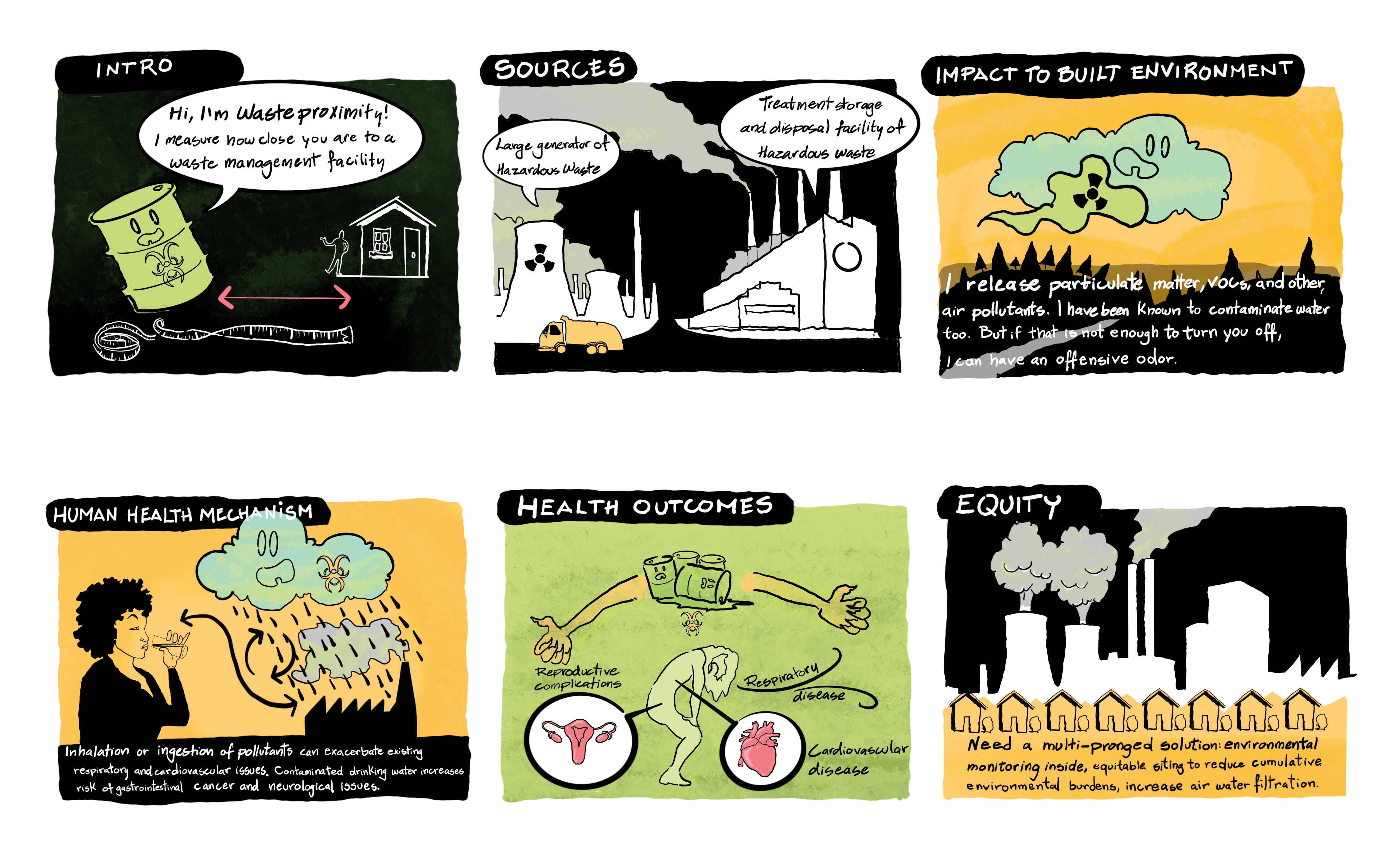
Click here for caption
Transcript: Hi, I’m waste proximity! I measure how close you are to a waste management facility. A waste management facility can mean either a large generator of hazardous waste or a treatment, storage and disposal facility of hazardous waste. These facilities can emit harmful pollutants and hazards to our environment through the air, water, and soil. When these pollutants are exposed, they’re very difficult to contain. Hazardous waste may contain a host of harmful chemicals, including carcinogens, pollutants, and toxicants. Therefore, the exact mechanism of how this affects our health depends on the type of hazardous waste in the facility. The harmful effects that hazardous waste facilities can have on us range from reproductive complications, cancers, respiratory diseases and cardiovascular disease. Where hazardous waste is disposed, treated and generated depends on where industrial activity is allowed. Oftentimes, communities with little political and economic power have to bear the burden of living near these facilities.
Definition
Hazardous waste facilities are defined by the Resource Conservation and Recovery Act (RCRA) as handlers that operate treatment, storage, and disposal facilities, or report large quantity generators from the 2021 Biennial Reporting.Human Health Mechanism
Hazardous waste may contain a host of harmful chemicals, including carcinogens and other toxicants. Therefore, the exact mechanism of how this affects our health depends on the type of hazardous waste in the facility. Distance of hazardous waste management facilities within 5 kilometers (km) have immense health impacts for children. For example, hazardous waste facilities can pose health and safety risks to students, staff, and residents in the area. Exposure to hazardous materials can lead to various health issues, including respiratory and cardiovascular problems, skin irritations, cancer, birth defects, and in severe cases, acute poisoning.Indicator Measurement
Data on waste proximity are provided by the US Environmental Protection Agency’s (US EPA) EJScreen, an environmental justice screening tool that uses national data to map places that are more vulnerable and susceptible to environmental burdens. Proximity to hazardous waste facilities is calculated as the number of waste facilities within 5 km, or nearest beyond 5 km, each divided by distance in km.Source of Exposures
Hazardous waste is waste that is potentially harmful to humans or the environment. It can come from many different sources including by-products of manufacturing processes, commercial chemical products, cleaning fluids, and pesticides. Facilities that handle waste may introduce pollutants into the environment through air emissions (i.e., incinerator stacks), pollutant run-off into nearby surface water bodies, or accidental releases or leakage from waste storage containers into soil and/or groundwater.Related Health Outcomes & Exposures
Asthma, COPD, Cancer, Cardiovascular DiseaseReferences
Click here for References
- Hazardous Waste Proximity Data Source: US EPA. EJScreen: Hazardous Waste Proximity. Data year 2021. Retrieved April 2023 from https://www.epa.gov/ejscreen/download-ejscreen-data
- Brender JD, Maantay JA, Chakraborty J. Residential proximity to environmental hazards and adverse health outcomes. Am J Public Health. 2011;101 Suppl 1(Suppl 1):S37-S52. doi:10.2105/AJPH.2011.300183
- California Department of Toxic Substances Control (CA DTSC). Defining Hazardous Waste. Department of Toxic Substances Control. Published January 2022. Accessed October 18, 2023. https://dtsc.ca.gov/defining-hazardous-waste/
- Council on Environmental Quality. Climate & Economic Justice Screening Tool :Methodology & Data. Accessed October 18, 2023. https://screeningtool.geoplatform.gov/en/methodology
- Mohai P, Kweon BS, Lee S, Ard K. Air pollution around schools is linked to poorer student health and academic performance. Health Aff (Millwood). 2011;30(5):852-862. doi:10.1377/hlthaff.2011.0077
- US EPA. Health and Ecological Hazards Caused by Hazardous Substances. Published May 17, 2013. Accessed October 18, 2023. https://www.epa.gov/emergency-response/health-and-ecological-hazards-caused-hazardous-substances
- US EPA. Frequent Questions about EJScreen. Published May 11, 2015. Accessed October 18, 2023. https://www.epa.gov/ejscreen/frequent-questions-about-ejscreen
- US EPA. Resource Conservation and Recovery Act (RCRA) and Federal Facilities. Published August 22, 2013. Accessed October 18, 2023. https://www.epa.gov/enforcement/resource-conservation-and-recovery-act-rcra-and-federal-facilities
- US General Services Administration (US GSA). GSA Sustainable Facilities Tool: Indoor Environmental Quality. Accessed October 18, 2023. https://sftool.gov/learn/about/1/indoor-environmental-quality-ieq
